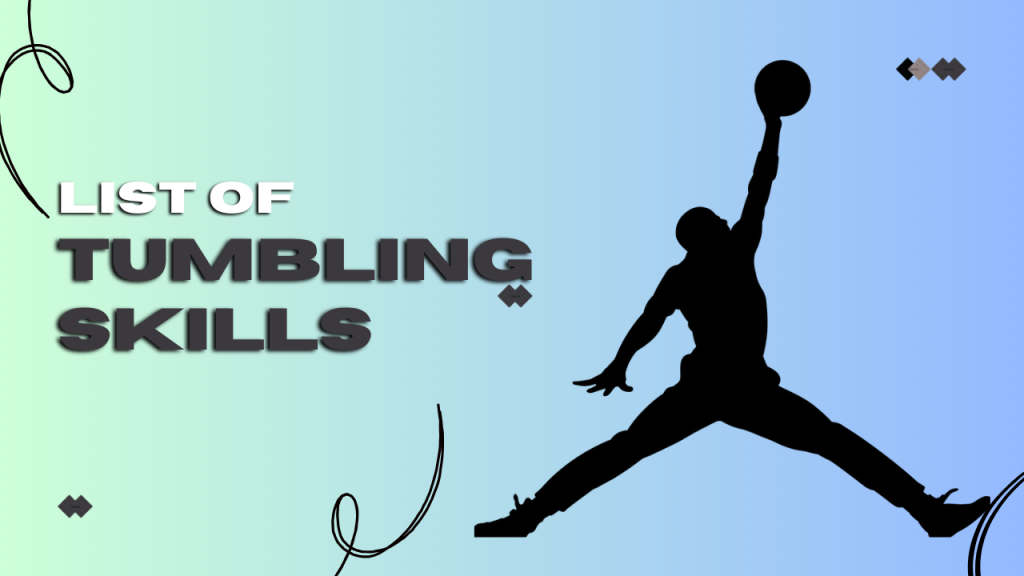Mastering the art of tumbling requires dedication, strength, and proper technique. Whether you are a cheerleader, gymnast, dancer, or simply someone interested in acrobatics, learning a structured list of tumbling skills can help you progress safely and efficiently. Tumbling is more than just flips and tricks it is a discipline that builds body awareness, coordination, and confidence. From the basics like forward rolls to advanced maneuvers such as full twists, tumbling develops an athlete’s ability to perform controlled movements with precision and style.
In this article, we will explore tumbling from the ground up, breaking down the essential skills by level, the importance of proper progression, and how each movement contributes to long-term success in cheer and gymnastics.
Understanding Tumbling and Its Importance
Tumbling is a form of acrobatics that focuses on dynamic floor skills performed without equipment. Unlike apparatus gymnastics, tumbling emphasizes sequences of flips, rolls, and aerial moves performed in a straight line or routine. The importance of tumbling lies not only in performance but also in physical development. It enhances agility, balance, flexibility, and muscular strength while improving overall athletic performance.
For cheerleaders, tumbling is often the centerpiece of a routine, showcasing athleticism and energy. For gymnasts, tumbling contributes to scoring in floor routines and helps build a strong foundation for vaults and beam dismounts. Beyond sports, tumbling also develops life skills such as discipline, perseverance, and confidence, making it a valuable pursuit for both children and adults.
Levels of Tumbling Skills
When exploring the list of tumbling skills, it is important to recognize that skills are divided into progressive levels. Each level builds on the previous one, ensuring athletes develop strong fundamentals before moving into more advanced tricks.
Level 1 Tumbling Skills
Level 1 introduces the fundamentals that every tumbler needs. Athletes at this stage focus on body awareness and control through movements like forward rolls, backward rolls, cartwheels, handstands, bridge kickovers, and round-offs. The emphasis is not on power but on proper form straight arms, pointed toes, and controlled landings. Coaches encourage repetition and technique refinement, ensuring beginners develop the strength and flexibility needed for higher-level skills. This stage also instills confidence, as athletes learn to trust their bodies and overcome the initial fear of inversion.
Level 2 Tumbling Skills
In Level 2, tumblers progress from simple rolls and stands to more challenging movements that require coordination and strength. Back walkovers and front walkovers introduce fluid motion across the mat, while the back handspring becomes a central milestone. Athletes also practice connecting a round-off into a back handspring, learning to transition smoothly between skills. This level is where tumblers first experience the thrill of combining power with technique. Flexibility, particularly in shoulders and back, becomes vital, and athletes begin building endurance by linking sequences of movements together.
Level 3 Tumbling Skills
By Level 3, tumblers are expected to execute skills with greater power and confidence. Running tumbling passes become common, often including multiple back handsprings connected in a sequence. Punch fronts, aerial cartwheels, and other no-handed tricks appear at this stage, testing balance and air awareness. Level 3 marks the turning point between beginner and intermediate tumbling, requiring athletes to master not only execution but also rhythm and timing. The ability to generate speed in a run and convert it into controlled tumbling power is crucial. At this point, athletes begin looking more performance-ready, with routines designed to impress both judges and audiences.
Level 4 Tumbling Skills
Level 4 takes tumbling to an advanced stage, introducing skills that require a combination of speed, strength, and refined technique. Standing tucks, back handsprings into tucks, layouts, and specialty passes become the focus. Tumblers learn to control their bodies in mid-air, maintaining tight form while completing flips and landings. The introduction of twisting elements adds a new layer of difficulty, as athletes must learn to rotate their bodies while flipping. This stage also demands strong mental focus, since mistakes at higher levels can lead to greater risks of injury. Athletes spend significant time conditioning and drilling to ensure safety and consistency.
Level 5 Tumbling Skills
At Level 5, tumbling showcases some of the most impressive athletic achievements. Full twisting layouts, Arabians, and highly technical combinations dominate this level. Athletes perform extended tumbling passes that link multiple advanced tricks, demonstrating stamina and skill. Tumblers must have not only excellent physical conditioning but also advanced air awareness, as timing becomes critical when executing flips and twists. Coaches emphasize precision and consistency because errors in technique at this level can disrupt entire routines. Athletes at Level 5 are often competitive cheerleaders or gymnasts aiming for national-level performance, where flawless execution is essential.
Level 6 Tumbling Skills
Level 6 is considered the pinnacle of tumbling skills, representing the highest degree of difficulty in cheerleading and gymnastics. Athletes at this stage execute double fulls, standing fulls, and elite passes that combine multiple flips, twists, and aerial transitions. The level demands maximum strength, flexibility, speed, and mental confidence. Conditioning becomes just as important as skill work, since the physical demands of Level 6 are intense. Athletes must consistently demonstrate flawless execution, as competitions at this level are judged with very high standards. This stage not only highlights technical mastery but also creativity, as routines are designed to stand out through originality and showmanship.
Building a Strong Foundation in Tumbling
Progression in tumbling is only possible with a solid foundation. Before attempting advanced flips or twists, athletes must develop strength, flexibility, and coordination through drills and conditioning. Core exercises, balance training, and stretching routines build the body’s readiness for the impact of tumbling. Athletes are also encouraged to perfect basic skills rather than rushing through levels, since even elite tumblers rely on solid cartwheels, round-offs, and back handsprings to transition between complex movements. A strong foundation ensures smoother advancement, fewer injuries, and a more confident approach to higher-level tricks.
Safety and Spotting in Tumbling
Safety is one of the most critical aspects of tumbling. Because the sport involves flipping and twisting the body, the risk of injury increases without proper precautions. Spotting, where a coach physically assists an athlete through a movement, is an important part of training at all levels. Spotters provide both safety and confidence, allowing athletes to attempt skills they might otherwise hesitate to perform. Additionally, using mats, spring floors, and progressive drills minimizes the impact on joints and helps athletes learn with reduced risk. Proper warm-ups, stretching, and conditioning are also essential, ensuring that the body is prepared for the physical demands of tumbling.
The Role of Tumbling in Cheerleading and Gymnastics
Tumbling plays a central role in cheerleading and gymnastics, serving both functional and aesthetic purposes. In cheerleading, tumbling adds excitement and difficulty to routines, often serving as the highlight that captures the judges’ attention. It showcases athleticism, synchronization, and team coordination. In gymnastics, tumbling is a key component of floor routines, where athletes are judged on execution, form, and artistry. Strong tumbling also supports other apparatus events, such as vaults or beam dismounts, where flipping and twisting are required. Without tumbling, routines would lack the dynamic energy that sets these sports apart, making it a core skill set for competitive athletes.
Developing Advanced Tumbling Skills
Achieving advanced tumbling requires far more than natural talent. Athletes must commit to consistent practice, strength training, and flexibility work. Visualization and mental preparation also play a huge role in advancing skills, as tumbling involves both physical and psychological demands. At higher levels, the margin for error is small, and confidence is crucial to performing with precision. Coaches emphasize breaking down complex tricks into progressions, ensuring athletes master each phase of the movement before attempting the full skill. This step-by-step approach prevents injury and builds consistency. Advanced tumbling is about mastery linking power, technique, and artistry into seamless performance.
Conclusion
Tumbling is a challenging yet rewarding discipline that combines athleticism, artistry, and dedication. Whether you are a beginner learning your first forward roll or an elite athlete performing twisting layouts, following a structured list of tumbling skills ensures safe progression and long-term success. With the right training, consistent practice, and focus on technique, athletes can achieve their goals and showcase their abilities in cheerleading, gymnastics, or performance arts. Tumbling is not just about skills it is about building confidence, discipline, and a passion for movement.
FAQs
What are the basic tumbling skills for beginners?
Beginners usually start with forward rolls, backward rolls, cartwheels, and handstands. These foundational skills teach balance, coordination, and body awareness.
How long does it take to master tumbling skills?
The timeline varies depending on practice frequency, conditioning, and natural ability. With consistent training, athletes can master beginner levels within a few months, while advanced tumbling may take years.
Is tumbling safe for children?
Yes, tumbling is safe when taught correctly under supervision. Children benefit from improved coordination, flexibility, and confidence, provided proper safety measures are followed.
Can tumbling help in other sports?
Absolutely. Tumbling improves agility, strength, and flexibility, which are beneficial in sports like dance, martial arts, and even team sports like soccer and basketball.
What is the hardest tumbling skill to learn?
Elite-level skills such as double fulls and standing fulls are considered some of the hardest due to their complexity, power requirements, and high execution standards.






[…] READ ABOUT: List of Tumbling skill -Your Guide to Mastering Moves […]